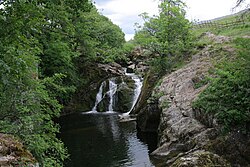River Doe

The River Doe is a river in the West Riding of Yorkshire, within the Yorkshire Dales. It is four and a half miles long, though the part bearing the name ‘Doe’ is just three and a half miles; the remaining miles being its main headwater, the Chapel Beck.
The river's source as the Chapel Beck is in a pool named the Jingle Pot just outside Chapel-le-Dale. From here the Beck flows south-west until it disappears underground at God's Bridge south-west of Chapel-le-Dale: the stream emerging from beneath the 'Bridge' is the River Doe. From here the Doe flows through Twisleton in a straight line in a south-westerly direction to Ingleton, where it meets the River Twiss, and the two rivers form the River Greta, a tributary of the River Lune.
Course
The nominal source of the River Doe is a place named God's Bridge, which is not a bridge but a natural formation where Chapel Beck disappears underground and the Doe emerges. From here the river flows south-west, fed by a number of small unnamed springs on sides of the dale. The first named tributary is Light Water Spring which feeds north-west into the river near a disused quarry.
Near Twisleton Dale House, the river can be crossed by some stepping stones at a fording point as well as some 700 yds later near the disused granite quarry. Further down stream near Twisleton Hall there are another set of stepping stones at a fording point just above Beezley Falls. After flowing under a footbridge, there are another set of falls, Snow Falls, just below the quarry which is operated by Hanson.[1]
The river continues past several disused quarries and a footbridge until it reaches the town of Ingleton where it forms a confluence with the River Twiss.
Waterfalls
- Beezley Falls are reached approximately two miles from the source at God's Bridge. These falls consist of a series of cascades, including the 'triple spout', running through Baxengyhll Gorge.
- Rival Falls have a plunge pool known as the Black Hole. The steepest drops are between 9 feet and 12 feet approximately.
- Snow Falls are in the lower gorge about half a mile downstream and have similar drops.[2]
Geology
The main rock of the river valley is turbidite sandstone with some siltstone which are prevalent in the waterfalls and plunge pools. These lay on a bed of Precambrian sedimentary rock which show evidence of its oceanic origins in the ripple and folding marks on exposed surfaces.[3]
Habitat
The river is home to Brown trout.[4] From Beezley falls to Snow falls, the sides of the gorge are lined with a variety of trees and shrubs.[5]
Gallery
Location
- Location map: 54°9’12"N, 2°28’15"W
- Map of the source: 54°10’58"N, 2°24’40"W
- Map of the confluence with the Twiss: 54°9’12"N, 2°28’15"W
| ("Wikimedia Commons" has material about River Doe) |
References
- ↑ "Active quarrying". Hanson Heidleberg Cement Group. http://www.heidelbergcement.com/NR/rdonlyres/75E5C76B-09C9-4937-A575-520D5DA1FC7A/0/Hanson_Quarry_Products_ISO_9001_QSRMC.pdf. Retrieved 15 January 2014.
- ↑ "UK River Guide - Doe". http://www.ukriversguidebook.co.uk/rivers/england/north-west/river-doe. Retrieved 15 January 2014.
- ↑ "River Doe Geology". http://www.ingletonwaterfallstrail.co.uk/trails.php. Retrieved 16 January 2014.
- ↑ "Fishing on the Doe". http://www.yorkshire-dales-flyfishing.com/rivers-doe-and-twiss.htm. Retrieved 16 January 2014.
- ↑ "Baxenghyll Gorge". http://www.ingletonwaterfallstrail.co.uk/trails.php. Retrieved 16 January 2014.




